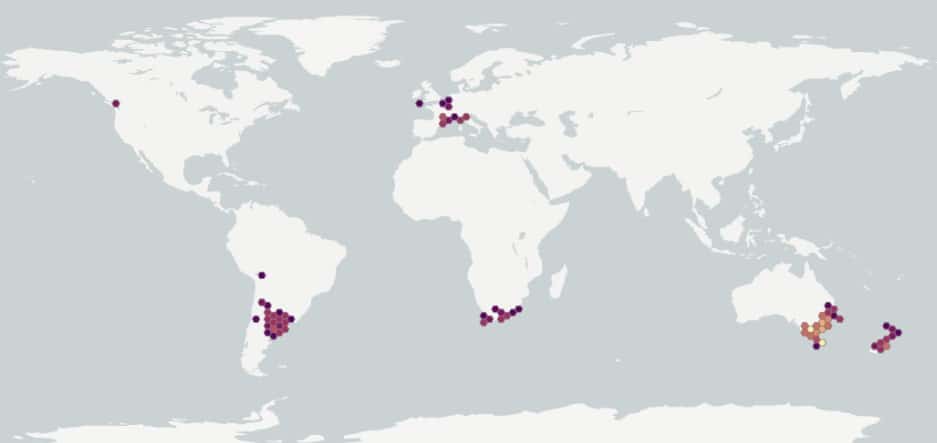Nassella trichotoma
Overview
Aperçu
Regulation :
Remarques Réglementation:
- CFIA Weed Seeds Order - Class 1: Prohibited Noxious Weed Seeds
- List of Pests Regulated by Canada
- USA Federal Noxious Weed List
- USA Federal Noxious Weed Seed List
Regulation Notes:
Prohibited Noxious, Class 1 in the Canadian Weed Seeds Order (2016) under the Seeds Act. All imported and domestic seed must be free of Prohibited Noxious weed seeds.
Distribution :
Répartition :
Native to southern South America and introduced to Australia, New Zealand, South Africa, the United States and, very locally, into Europe (Westbrooks and Cross 1993; USDA-ARS 2021). Absent from Canada (Brouillet et al. 2010+).
Habitat and Crop Association :
Habitat et Cultures Associées :
Natural and managed grasslands, natural forests, coastal areas, railways, roadsides and disturbed areas (CABI 2021). In Australia, it has infested almost a million hectares of pastureland (Westbrooks and Cross 1992; CABI 2021).
Economic Use, cultivation area, and Weed Association :
Utilisation économique, zone de culture et association de mauvaises herbes :
Duration of Life Cycle :
Durée du cycle vital:
Perennial
Dispersal Unit Type :
Type d’unité de dispersion :
Floret
General Information
RENSEIGNEMENTS GÉNÉRAUX
Nassella trichotoma is a tall, tussock-forming plant that out-competes native species and reduces biodiversity (Carr et al. 1992). It was introduced into the United States in the late 1980’s in contaminated grass seed (Westbrooks and Cross 1993), these populations are under control (Barkworth et al 2007).
The species spreads by seeds that are shed from the panicles as they tumble along the ground and then remain viable in the soil (Westbrooks and Cross 1993). The majority of the seeds are produced from self-pollinating florets, creating clones of the parent plant (Osmond et al. 2008).
.
Nassella trichotoma plant (USDA APHIS PPQ – Oxford, North Carolina , USDA APHIS PPQ, Bugwood.org)
Identification
Identification
-
Spikelet
Size
- Spikelet length: 4.0 – 10.0 mm; width: 0.9 – 1.2 mm (Barkworth et al. 2007)
Shape
- Spikelet consists of a pair of long, teardrop-shaped glumes that surround the floret
Surface Texture
- Spikelet surface is smooth, with short hairs along longitudinal nerves
Colour
- Spikelet is translucent light brown, reddish-brown or purple coloured
Other Features
- Ends of glumes are long and pointed
- Glumes are left behind on the stalk when the florets are dispersed
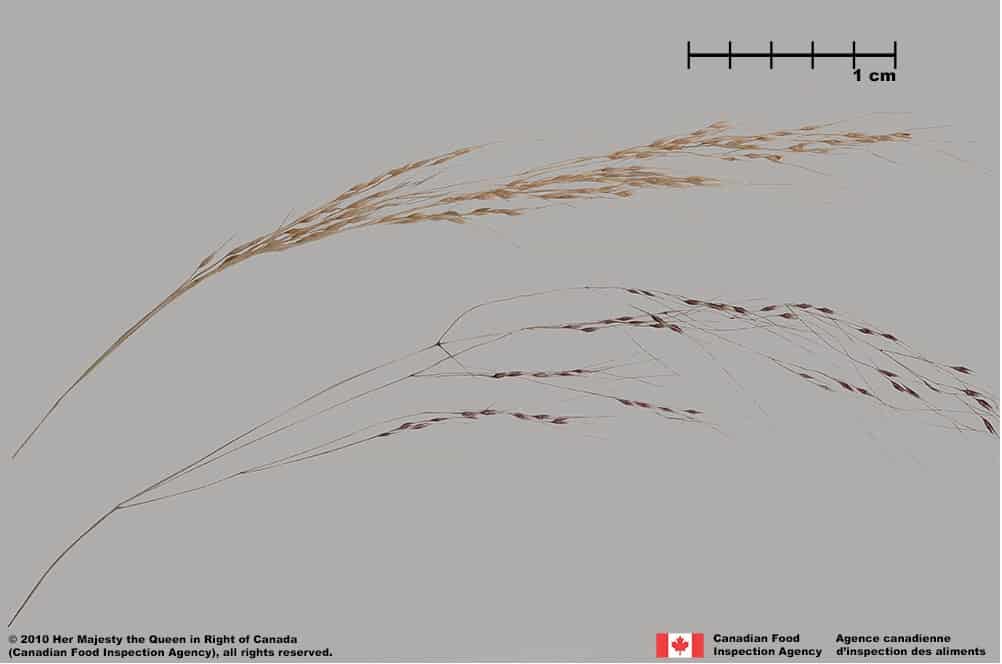
Serrated tussock (Nassella trichotoma) spikelets in panicle

-
Floret
Size
- Floret length*: 1.7 – 2.5 mm; width: 0.6 – 0.9 mm
*Note: minimum and maximum of 10 florets in a normal range of this species using image measurement (ISMA 2020)
Shape
- Egg-shaped floret, compressed in edge view with a pointed narrow end and truncate wide end
Surface Texture
- Floret surface is covered with warty tubercles that increase in size towards the top
- Floret surface has 3 longitudinal nerves
Colour
- Floret is glossy straw yellow or light brown coloured
Other Features
Lemma awn
- Awn length*: 23.9 – 42.3 mm, often broken during processing
- Awn arises from one side of the wide end of the floret
*Note: minimum and maximum of 10 floret awns in a normal range of this species using image measurement (ISMA 2020)
Callus and Rachilla
- A narrow, pointed callus (length: 0.1 – 0.3 mm, Barkworth et al. 2007) at the narrow end of the floret is surrounded by long, white coloured bristles
Other Features
- The lemma of the floret has a hard, shell-like consistency and wraps around the palea
- The palea is small, flat and generally not visible.

Serrated tussock (Nassella trichotoma) florets

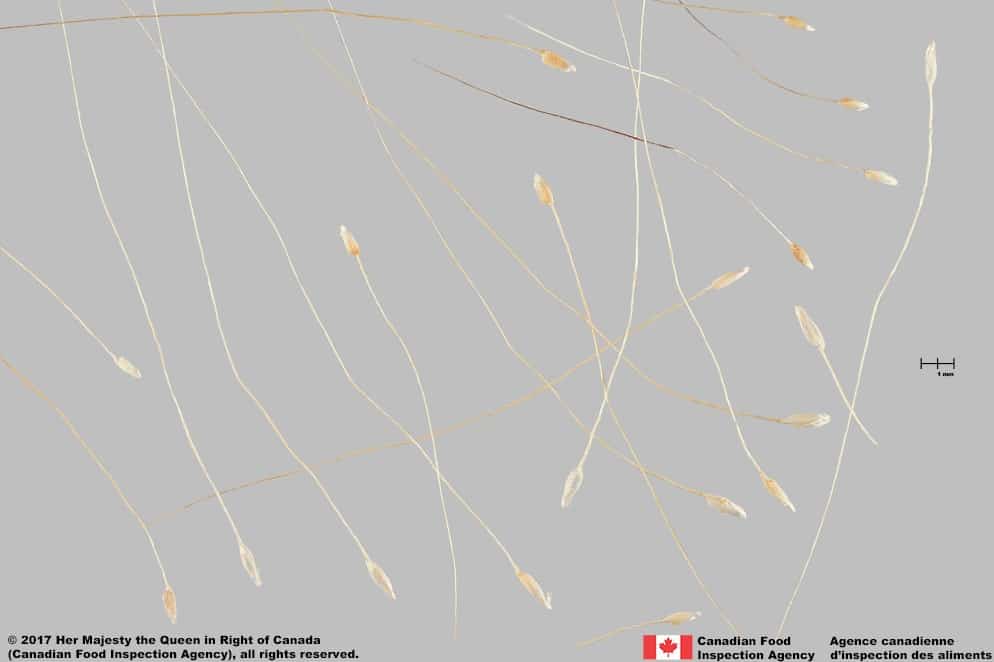



-
Caryopsis
Size
- Caryopsis length: 1.2 mm (Barkworth et al. 2007)
Shape
- Caryopsis is wedge shaped, slightly compressed in edge view
Surface Texture
- Caryopsis surface is smooth-textured
Colour
- Caryopsis is orange coloured
-
Embryo
Size
- Embryo is a rudimentary size compared to the caryopsis
Shape
- Embryo is egg-shaped, in a lateral position at one end of the caryopsis
Endosperm
- Endosperm is hard and translucent orange coloured
Identification Tips
CONSEILS POUR L’IDENTIFICATION
The unusual egg shape of the florets of this species is distinctive compared to the oval or teardrop shape of the florets in Nassella species. Species in the Piptochaetium genus also have similar shaped florets, but are dark brown in colour.

Serrated tussock (Nassella trichotoma) floret





Additional Botany Information
AUTRES RENSEIGNEMENTS BOTANIQUES
Similar Species
ESPÈCES SEMBLABLES
Similar species are based on a study of seed morphology of various species, and those with similar dispersal units are identified. The study is limited by physical specimen and literature availability at the time of examination, and possibly impacted by the subjectivity of the authors based on their knowledge and experience. Providing similar species information for seed identification is to make users aware of similarities that could possibly result in misidentification.
Piptochaetium montevidense (Spreng.) Parodi (Uruguayan rice grass)
P. montevidense florets are generally shorter but wider (length*: 1.6 – 1.9 mm; width: 1.0 – 1.4 mm), dark brown and have longitudinal ridges between the warty tubercles, unlike the straw yellow colour and smooth surface between the tubercles on N. trichotoma florets.
*Note: minimum and maximum of 10 florets in a normal range of this species using image measurement (ISMA 2020)
Click to select species
Cliquez pour sélectionner les espèces
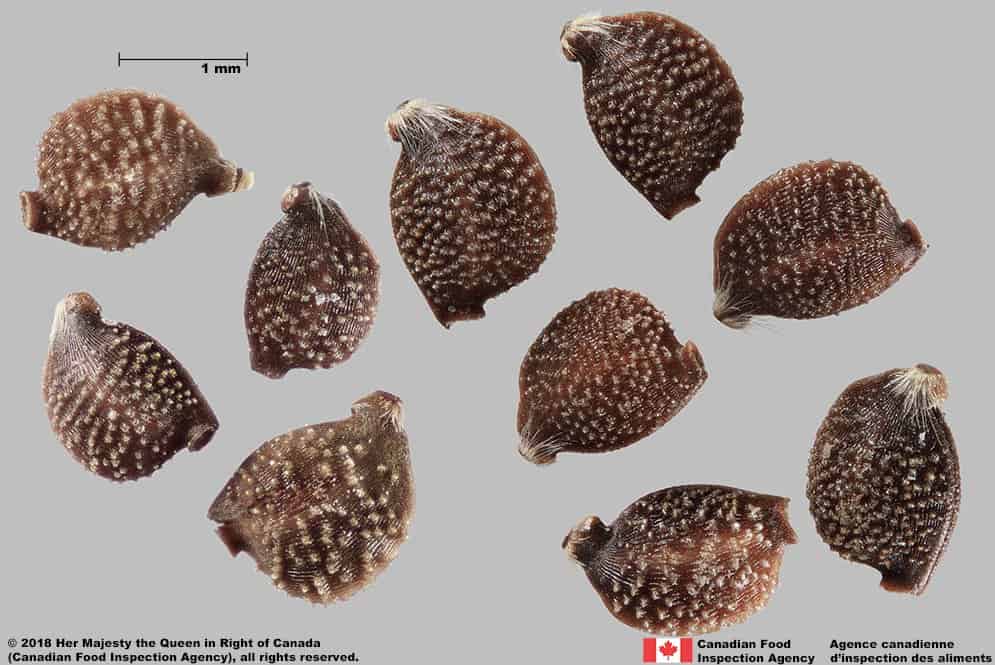
Piptochaetium montevidense
Comparison Window
Fenêtre de comparaison
MAIN SPECIES
ESPÈCES PRINCIPALES
Nassella trichotoma

Nassella trichotoma
Poaceae
Serrated tussock (Nassella trichotoma) florets
MAIN SPECIES
ESPÈCES PRINCIPALES
Nassella trichotoma

Nassella trichotoma
Poaceae
Serrated tussock (Nassella trichotoma) florets
MAIN SPECIES
ESPÈCES PRINCIPALES
Nassella trichotoma

Nassella trichotoma
Poaceae
Serrated tussock (Nassella trichotoma) floret
MAIN SPECIES
ESPÈCES PRINCIPALES
Nassella trichotoma

Nassella trichotoma
Poaceae
Serrated tussock (Nassella trichotoma) floret, side view
MAIN SPECIES
ESPÈCES PRINCIPALES
Nassella trichotoma

Nassella trichotoma
Poaceae
Serrated tussock (Nassella trichotoma), the base of the floret
MAIN SPECIES
ESPÈCES PRINCIPALES
Nassella trichotoma

Nassella trichotoma
Poaceae
Serrated tussock (Nassella trichotoma) spikelets in panicle
SIMILAR SPECIES
ESPÈCES SEMBLABLES
Piptochaetium montevidense

Piptochaetium montevidense
Poaceae
Uruguayan rice grass (Piptochaetium montevidense) florets
SIMILAR SPECIES
ESPÈCES SEMBLABLES
Piptochaetium montevidense
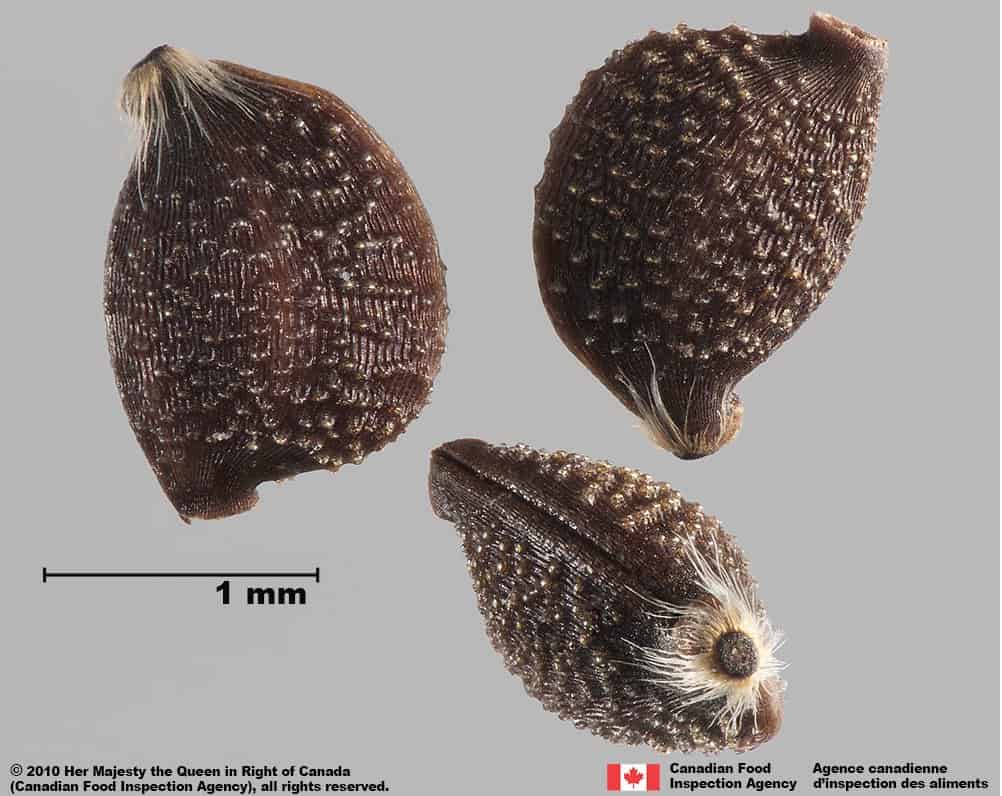
Piptochaetium montevidense
Poaceae
Uruguayan rice grass (Piptochaetium montevidense) florets
SIMILAR SPECIES
ESPÈCES SEMBLABLES
Piptochaetium montevidense

Piptochaetium montevidense
Poaceae
Uruguayan rice grass (Piptochaetium montevidense) floret
Need ID Help?
Besoin d’aide pour l’identification?
Reference(s)
Référence(s)
Barkworth, M. E., K. M. Capels, S. Long, and M. B. Piep, (eds.) 2007. Flora of North America Volume 24. Magnoliophyta: Commelinidae (in part): Poaceae, part 1. Oxford University Press, New York, New York.
Brouillet, L., Coursol, F., Meades, S.J., Favreau, M., Anions, M., Bélisle, P. and Desmet, P. 2010+. VASCAN, the database of vascular plants of Canada. http://data.canadensys.net/vascan/ Accessed April 1, 2021.
Centre for Agriculture and Bioscience International (CABI). 2022. Invasive Species Compendium, CAB International, Wallingford, UK. https://www.cabidigitallibrary.org/journal/cabicompendium Accessed April 1, 2021.
Carr, G. W., J. V. Yugovic, and K. E. Robinson, 1992. Environmental weed invasions in Victoria. Department of Conservation and Environment and Ecological Horticulture Pty. Ltd.
Flora of North America (FNA) Editorial Committee, eds. 1993+. Flora of North America North of Mexico [Online]. 22+ vols. New York and Oxford. Accessed December 29, 2022.
Global Biodiversity Information Facility (GBIF) Secretariat. 2022. https://doi.org/10.15468/39omei Accessed via https://www.gbif.org/species/9613389 Accessed December 29, 2022.
Government of Canada (GC). 2016. Canadian Weed Seeds Order. https://laws-lois.justice.gc.ca/eng/regulations/SOR-2016-93/page-2.html (English) https://laws-lois.justice.gc.ca/fra/reglements/DORS-2016-93/page-2.html (French)
Integrated Taxonomic Information System (ITIS). 2021. https://www.itis.gov/ Accessed April1, 2021.
International Seed Morphology Association (ISMA). 2020. Method for Seed Size Measurement. Version 1.0. ISMA Publication Guide. https://www.idseed.org/authors/details/method_for_seed_size_measurement.html
Osmond, R., M. Veebeek, D. A. McLaren, M. Michelmore, B. Wicks, C.J. Grech, and P. Fullerton, 2008. Serrated tussock – National best practice manual. Victorian Department of Primary Industries, http://www.weeds.org.au/WoNS/serratedtussock/docs/stbpmmi.pdf Accessed May 30, 2016.
U.S. Department of Agriculture-Agricultural Research Services (USDA-ARS). 2021. Germplasm Resources Information Network (GRIN), https://npgsweb.ars-grin.gov/gringlobal/taxon/taxonomysimple.aspx Accessed April 1, 2021.
Westbrooks, R. and G. Cross, 1993. Serrated Tussock (Nassella trichotoma) in the United States. Weed Technology 7: 525-529.




